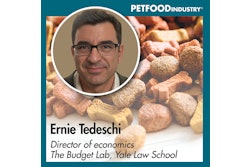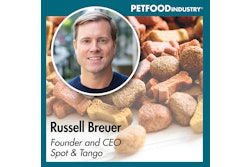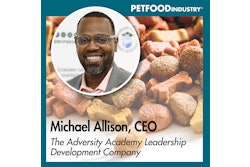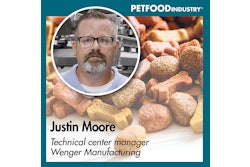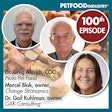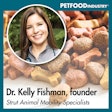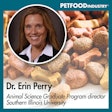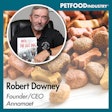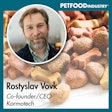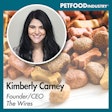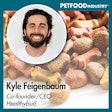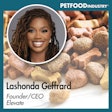
Shrimp meal has long been used in pet food as an attractant, but its role is expanding due to growing interest in chitosan, a byproduct of shrimp processing with numerous applications. In a recent discussion, industry experts highlighted how shrimp byproducts, now referred to as "secondary yield," are gaining traction in both human and pet nutrition. Lindsay Beaton and ChitoLytic CEO Michel Lockhart take a look at this promising ingredient for pet food.
The below transcript is from Episode 83 of the Trending: Pet Food podcast, where host Lindsay Beaton and Michel Lockhart, CEO of ChitoLytic, answer the question, “What are the possibilities for shrimp byproducts as pet food ingredients?” You can find the episode at Trending: Pet Food Podcast, on SoundCloud or on your favorite podcast platform. This episode originally aired on March 26, 2025.
We want to thank AFB International for sponsoring this podcast. AFB is the premier supplier of palatants to pet food companies worldwide offering off-the-shelf and custom solutions that make pet food treats and supplements taste great.
Lindsay Beaton, editor, Petfood Industry magazine and host, Trending: Pet Food podcast: Hello, and welcome to Trending: Pet Food, the industry podcast where we cover all the latest hot topics and trends in pet food. I’m your host and editor of Petfood Industry magazine Lindsay Beaton, and I’m here today with Michel Lockhart, CEO of Chitolytic Inc. Hi Michel, and welcome!
Michel Lockhart, CEO of ChitoLytic Inc.: Hi Lindsay. How are you doing?
Beaton: Pretty good so far! In case you’re unfamiliar with Michel or Chitolytic, here’s what you need to know.
Michel is a recognized business development executive with over 40 years of experience in the life sciences across drugs, nutraceuticals, and food. His career started excelling in positions with big pharma companies like Johnson & Johnson, and in the mid-1990s he shifted from commercializing drugs to more natural products such as food ingredients and natural medicine. For example, he worked with companies such as Aker Biomarine and Acasti Pharma in upvaluing krill oil products, bringing them through controlled trials in lupus patients at the Hospital of Special Surgery in NYC.
Throughout his career, he has orchestrated over 70 successful life sciences projects, amassing over $4.0 billion in value in global markets. His cornerstone is that he works to transform the science behind more natural materials and ingredients into highly valuable commercial products.
Chitolytic Inc. is a specialty chitosan manufacturer and supplier. It is one of the only companies in the world that provides consistent batch-to-batch high-quality chitosan for use in most of the over 400 chitosan application areas, such as pharmaceuticals, biomedical, agriculture and food and feed ingredients, including a focus on pet food.
Michel's extensive experience in commercializing marine-derived products provides unique insights into their nutritional value, and his current focus on shrimp byproducts and chitosan are why I’ve brought him on today and answer this question: What are the possibilities for shrimp byproducts as pet food ingredients?
Michel, I want to talk a little bit about how all the various crustacean meals even entered both the human food space and then expanded into the pet food space, because that's usually where the ingredients come from, right? They start out in the human food, and then somebody looks at them and goes, “Oh, wait, there's another application for this,” and they land in pet food. What has that evolution look like for these ingredients?
Lockhart: It’s an interesting question. Firstly, shrimp meal is a recognized ingredient in the pet food industry for quite a while now, but it has been used mostly as an attractant and to create palliative benefits. But lately, it has gone to the next level. It's gone to the next level primarily because of chitosan, which is a byproduct of the shrimp secondary yield, or waste some people like to call it. Chitosan is bringing about significant interest in the over 400 applications that chitosan has been cited as.
The planet is moving away from the use of fossil fuels and chemicals, and with that, the question is, what are we going to use to make our products? We're going to have to use biomaterials, as we're starting to use now, and chitosan is the second most abundant of our natural polymers on the planet, second only to cellulose. Cellulose being in all our trees and plants. Chitosan is in our crustacean shells and exoskeletons of insects and cell walls of fungi, so it's just everywhere.
The significant difference between cellulose and chitosan is that chitosan is a more flexible chemical than cellulose. It can be used for so many different application areas, which has prompted a renewed interest in the use of the shrimp byproducts in food and feed applications.
Beaton: Now the word “byproducts” has become a loaded word, if you will, in the human food space, in the pet food space, because people see the word “byproducts” and they think “waste.” They think something that's not nutritious.
Now we know that that is not necessarily true, that animal byproducts have high nutritional value and that there is a lot that can be done with it, but the damage has been done from a marketing and consumer standpoint. What does that look like from a seafood perspective? There’s been damage done in terms of cow byproducts and chicken meal – is it the same in the seafood space? Or are people not as concerned about the word “byproducts” when it comes to seafood?
Lockhart: First, thank you so much for that question, because I'm guilty of calling it “waste” and “byproducts” often. I was taught and scolded many times by a veteran in the seafood industry, Melanie Siggs, who's one of the directors at the Global Seafood Alliance. She’s coined the phrase “secondary yield” of the shrimp, which is a better term to use. It truly is a secondary part of the process after we get rid of some of the material for human consumption. It is different somewhat from an animal secondary yield, as it were, because marine materials are usually eaten whole by other marine animals. Everything within the shrimp itself is consumable.
Secondly, I think it's different, because we as humans eat a lot of shrimp. It's the most consumed of the seafoods out there. The latest figure that has been cited is that we eat about 5.5 pounds annually, compared to 3.2 or 3.3 pounds per year of salmon as the second most consumed.
We really eat a lot of shrimp, and we eat it whole. We eat all parts of it. The term “secondary yield” would bring about a more positive tilt. Again, there is a more positive feel when we speak about the secondary yield coming from seafood.
Beaton: How does shrimp compare to other seafood ingredients in pet food? When formulators come to you, are they looking for it to serve the same purposes, like the alternative protein or seafood protein purpose? You mentioned that it has been used as an attractant and as a palatant. Does it get used as a primary protein? Or are you seeing that being asked?
Lockhart: No, and I think that's the opportunity. That's one of the charges we have coming to both the aquaculture and the pet food market is that it's much more than an attractant or palatant. We must look at the basic components of the shrimp and make some decisions there.
When we do that, we look at its closest relative we have experience with, and that's krill. Its components are very much like krill in that it has the EPAs, the DHAs, the proteins. The difference is with fish or other marine nutrients, its nutrients, including the EPA and DHA trim are bound to phospholipids, as opposed to triglycerides.
What that means is these nutrients are more bioavailable. They easily enter the cells. They're more soluble, thus they're more digestible and bioavailable. For example, one gram of EPA DHA delivered on a triglyceride backbone, as with fish, will not have the same bioavailability as a phospholipid-bound EPA DHA. You just get more nutrients per gram.
Beaton: It sounds like this ingredient, or this group of ingredients, could fit in to the functional ingredient trend.
Lockhart: You are absolutely right. I like to say that for many years, now, decades, I guess, shrimp has been swimming on the tails of fish and thus been characterized as only an attractant and only as a palatant enhancer sort of material. But it does much more. I like to say it does much more -- just ask the fish. The fish themselves consume lower standing materials on the food chain, such as krill, such as shrimp, to get their nutrient profile. That's indicative of the excellent functionality of the materials in shrimp.
Beaton: The other big thing that's going on right now, the other big buzzword, the big trend, is sustainability. I know that that has hit the seafood space like it has hit every other space. Where does this class of ingredients fall in the sustainability umbrella? Are there challenges, opportunities there? What does that look like? What kind of conversations are being had?
Lockhart: That's a significant opportunity we see in the shrimp secondary yield market. Because we are such large consumers of shrimp, it results in a lot of shrimp byproducts.
I think the latest figures globally, there was about eight to 10 million metric tons of shrimp that are discarded. Much of it is discarded back into landfills, back into the oceans. There is a significant amount of these bioactive materials just not being used. We are consuming the shrimp and processing the shrimp, so these materials are available.
It really speaks to the new trend towards 100%utilization for us. Once the shrimp is processed and you have remnants of the tails, the head, the shell of the fish, we then move on to process it into hydrolyzed shrimp meal, for example. That hydrolyzed shrimp meal then moves on to process the shells that come from that process, and ultimately, what we get is 100% utilization. Very much like nature herself, she does not waste anything.
All in all, it's an excellent sustainability story for shrimp moving forward. That is something that we would like to educate all industries, including the pet food industry, is what you can expect with shrimp secondary yield products.
Beaton: Now, regular listeners of this podcast will know that you just said the magic word “educate.” I adore a good education conversation, because largely, that's what this podcast overall is about. I want to educate the industry and talk to people who can help do that.
But I also want to talk to the industry about how difficult it can be to educate their customers and the end consumer in the case of an ingredient company. What are the current challenges that you're facing in trying to educate formulators? We've discussed how this class of ingredients has kind of stuck as a palatant and seen as an attractant, but it can be so much more.
Are you finding that the industry is receptive to these conversations, or is there a significant educational component having to happen in allowing people to see the science beyond what it's already known for and used for?
Lockhart: That’s an interesting question. I see it on two levels, education to the consumer and education to industry. This is where I borrow a lot of my experience with the krill industry. The krill industry is doing very well. There are a lot of krill supplements that are being used, not only for supplementation, but now actually, as true nutraceutical medicine.
With the consumer, it was very difficult at first, because nobody knew what krill was. Shrimp will not have that problem. As I mentioned, everybody knows shrimp, obviously is the most consumed of our seafood. In terms of educating the consumer, there's a door open for relatively easy education that you know the shrimp that you're eating, or the shrimp secondary yield products that you and your pets are consuming, are good. They're tasty, yes, but they do a lot more than providing a good taste in terms of the industry.
Then it gets a little bit more complicated. Presently, shrimp does not have any significant science behind it. For us, that's an opportunity to build that science, to prove out that its components really provide those functional ingredient benefits.
Krill has led the way. We use a lot of translational science from krill because of the similarity of their components and nutritional profile. With my short foray into the pet industry and aquaculture, for that matter, I found that when I speak about the benefits of the component profile and nutritional profile of shrimp, when we speak to the scientists within the industry, they understand it. It's a given for them. They understand that, yes, the nutrients within shrimp are bound and conjugated to phospholipids. It just makes perfect sense. It's almost like biochemistry 101.
When we get away from the scientists and the lab within these industries, then it's not clear. That's where the education must come, more so towards the executives within these industries. Within the pet industries, the science is clear. We must document the science, and that's what we're doing. We must get the scientists within the pet food industry to speak with the executives and let them know that the science is there. It's just logical sense.
Then we put the whole package together by explaining what the potential holistic benefits are from having the science being built up -- all the sustainability issues that we are addressing as a company, all the supply chain issues that we are addressing.
We have a good story for not only the science behind shrimp in the pet industry, but also the value proposition going to the market and to the consumer.
Beaton: We're going to wrap up with the future. I want to talk about the present for a moment. You mentioned things like supply chain. What is the state of things right now in terms of shrimp supply and being able to get this ingredient? Has everything steadied out in the last few years after a global upheaval or are there still concerns on that front in terms of being able to reliably upscale and maintain the inflow of this ingredient?
Lockhart: It's interesting. The shrimp Industry was and still is primarily dominated by processors coming out of Asia, specifically places like Vietnam, India and certainly the Far East. With that, the supply chain has been recognized as somewhat erratic where there's not a consistent supply, not consistent quality coming out of those regions.
This is where, from a business perspective, we have identified the opportunity. This is why we have now partnered with partners in Ecuador, for example, which is largest shrimp exporting country as we speak, where we can work with them and work with their solidified supply chain to the point where we could now have 100% control of the chain of custody from hatchery of farmed shrimp all the way up through the shrimp on the table. That is significantly important.
The supply chain, bringing it closer to home, so to speak, allows us access to a more risk-free supply chain. That is necessary and something that we can offer to to the pet food industry, whereas they were not used to getting that type of risk-free solidified, fully traceable supply chain. That adds into the value proposition that we're bringing forward.
It's somewhat of a change to the industry and how shrimp secondary yield products are viewed.
Beaton: We're recording this on January 13, so we're early into the new year, about two weeks. What do you think shrimp byproducts are going to look like in 2025? Over the next five years? What's trending? Where does it look like it's headed?
Lockhart: It’s twofold. When we talk about hydrolyzed shrimp meal, that product is basically up and ready to go. It's ready to replace or complement other ingredients within pet foods, for example, and bring that additional functionality to a formulation where marine source protein is sought, one that is both nutritional and functional has excellent sustainability benefits. It’s pretty well ready to go.
Again, it is to educate the industry and let them know that you can go way past the benefits of increased palatability. You could go to the points of better digestibility of low molecular peptides, significantly bioactive and deliver the EPAs and DHAs is that you come to get used to and additional nutrients, such as choline, for example. I should have mentioned that the phospholipid fraction within shrimp is what they call phosphatidylcholine. It's a natural delivery of choline within a formulation. It has all these potential benefits that are ready to go in 2025.
The second part of the equation is the chitosan. The chitosan itself is now further downstream processing of the secondary yield -- one can call it the tertiary yield -- as the shrimp material. All of the proteins and the fats are extracted, and we’re left with the shrimp shell, which is converted into chitin and then chitosan.
That is a slower process that is a newer material to the pet food industry, and it's being tested by some of the pet food manufacturers as we speak, utilizing the chitosan now as a natural dietary fiber that has significant bioactive functionalities, like being a prebiotic, natural antimicrobial properties, support to the digestive system. It's a toxin-binder, for example, which helps to prevent the absorption of some toxins. It has a variety of different additional benefits compared to, let's say, the hydrolyzed shrimp.
So in 2025, we see chitosan continually being studied in different types of formulations for different types of targeted functionalities.
Beaton: Well, that's great. I really enjoy being able to do deep dives into a particular ingredient. It’s so easy to generalize and keep them in their larger classes, but to see how an individual ingredient could work in a specific industry, especially right now, when conversations about sustainability and novel proteins and functional ingredients are so important to the pet food industry, I think it's really important to be able to home in on some specific ingredients. It’s been a while since I've covered a seafood ingredient. Thank you very much for coming on today, Michel.
Lockhart: Thank you very much, because this certainly lends into one of our major objectives is to educate the world, if you will, in some sense, and certainly the pet industry. Because as old as the ingredient is, it seems sometimes that it's relatively new since it's been overlooked and underappreciated. We look to help fill the educational gap as we move forward.
Beaton: To that end, let's do a little plug. Where can people find more information about you and ChitoLytic?
Lockhart: You can find us on the internet at chitolytic.com, contact us there or via email at [email protected], and we’ll get back to you with any inquiries that you may have.
Beaton: That’s it for this episode of Trending: Pet Food. You can find us on PetfoodIndustry.com, SoundCloud or your favorite podcast platform. You can also follow us on Instagram, @trendingpetfoodpodcast. And if you want to chat or have any feedback, I'd love to hear from you. Feel free to drop me an email: [email protected].
Of course, thanks again to our sponsor, AFB International, the premier supplier of palatants to pet food companies worldwide, offering off-the-shelf and custom solutions that make pet food treats and supplements taste great.
Once again, I'm Lindsay Beaton, your host and editor of Petfood Industry magazine, and we'll talk to you next time. Thanks for tuning in!


